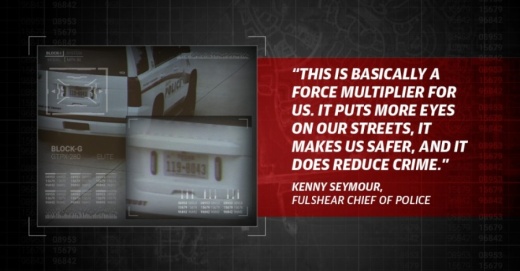At the May 19 regular council meeting, Fulshear Police Chief Kenny Seymour said his goal is to install 25 license plate readers to help his department solve burglaries and break-ins; only about 15%-20% of those cases are ever solved.
“[License plate readers] gives us about an 85% change of solving these cases because now, we have something that we can document on the streets [and] refer back to when the officers are not present or the citizen doesn’t capture it,” he said.
In May 21 phone interview, Seymour said the readers will be installed at nearly every major intersection over the next four to six weeks. FPD has had about five readers on a trial basis for six to seven months, he said at the meeting.
Fort Bend County, homeowners associations, such as Churchill Farms HOA, and cities, including Katy, Sugar Land and Jersey Village—which experienced a 35% reduction in crime after installing more than 40 readers—have already installed these readers. Together, these entities share data and create a network to help solve crimes, Seymour said at the meeting; he further stressed in the phone interview that this information sharing is critical among law enforcement.
“This is basically a force multiplier for us,” Seymour said at the meeting. “It puts more eyes on our streets, it makes us safer, and it does reduce crime.”
The license plate readers, which Fulshear will lease from an Atlanta-based technology company Flock Safety, will cost about $2,000 annual per reader, he said at the meeting.
To help share the cost, Seymour reached out to four Fulshear-area municipal utility districts, three of which agreed to lease 10 readers, he said. The city will lease the remaining 15, and the funding will come from the capital improvement program.
Fulshear City Council approved the agreements with the MUDs—Fort Bend MUD Nos. 170, 172 and 173—at the regular May 19 meeting. Seymour said in the interview he will not have to return to council for the remaining readers.
How the license plate readers work
Joshua Miller, who works in public relations at Flock Safety, previously told Community Impact Newspaper that the motion-activated license plate readers are not surveillance cameras on a constant loop.
Instead, Miller said, the devices will capture a series of photos to store vehicle information, such as the make, model, color, plate and any aesthetic damages, as the vehicle passes by the camera. They will also capture bicycles and pedestrians. Images will then be sent to the cloud for police to access as needed.
All data will be automatically and permanently deleted after 30 days, as the types of crimes intended to be solved with the license plate readers do not require footage going back more than one month, Miller said.





